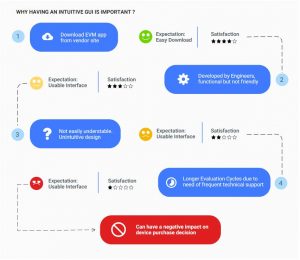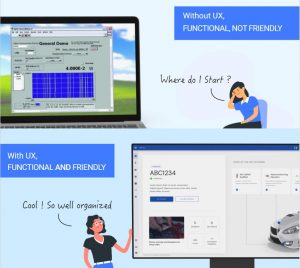Imagine going to the movies to watch a terrific actor play a fascinating new role, only to be disappointed by a sub-par screenplay or direction. Or imagine laying hands on the latest, coolest computer, only to realize that it runs an antiquated browser. The frustration is real and is caused by a mismatch in the potential promise that one component holds and the apparent disregard for the suitability of another seemingly less important component.
A similar situation existed in the semiconductor evaluation GUI world. End customers, who are used to user-centric and sophisticated consumer apps and products such as the iPhone and its apps, could be put off by a mediocre evaluation experience that results from poor delivery experience, insufficient technical support, or non-intuitive software interface, despite the semiconductor chip itself being exceptionally well designed. This could have serious effects on the user’s buying decision and consequentially, the product’s success.
Some of the pioneering semiconductor companies that we work with are now exploring the possibility of providing the same exceptional experience as consumer apps/products, to their Evaluation GUI users. Read on to see some of the key improvements that Soliton has been able to introduce with user-centric design.
The Semiconductor Journey
When a product designer wants to evaluate the suitability of a semiconductor chip for her product, she orders a sample. The semiconductor company usually provides this in the form of an EVM – Evaluation Module (which is basically a circuit board with various connectors and ports and indicators), and software that helps the designer probe the chip functions. After extensive analysis and testing, the product engineer may be satisfied with the suitability of the chip for her product and proceed to place an order. This is a crucial stage in the customer’s buying journey. It is therefore vital that the semiconductor companies ensure a smooth experience for the user. And user experience (UX) based design can help transform this overall user journey and reduce the need for extensive support from the chip manufacturer. However, the actual scenario was very much different, as shown in the user journey map below.

The role of UX
UX design seems to be a relatively new concept in the semiconductor software space, and it is only right to first give an introduction to it. While we hope to write more detailed articles about this in the coming months, here is a quick definition of UX from the Interaction Design Foundation
“User experience (UX) design is the process design teams use to create products that provide meaningful and relevant experiences to users. This involves the design of the entire process of acquiring and integrating the product, including aspects of branding, design, usability, and function.”

The Soliton Impact
With this understanding, Soliton’s engineering team and UX design team were able to work with semiconductor companies and identify several ways in which the Evaluation Experience could be significantly improved:
Remote Evaluation
Remote evaluation expedites access to the chips, thereby helping to overcome issues with logistics. Imagine the potential for such a model in times such as these, when working from home is the new norm, access to labs is limited, and when shipment delays are expected. Soliton has successfully integrated this function into the Plexus framework for IC Evaluation GUIs.
User-Centric Flow
Novice users are often perplexed about the starting point for the evaluation process. The UI is designed with two easily discernible user flows
(1) The beginner/quick start flow and
(2) The advanced user flow.
This setup enables a new user to easily follow steps to set up the hardware and probe its functions, and also provides the advanced users with access to complex controls and settings without frustrating either type of users with irrelevant information.
Better Organization of Information
Datasheets, hardware setups videos, and user manuals are seamlessly integrated into the GUI to save the user’s time and to quicken the learning curve.
Clean, Visually Guided GUI
A user experience-based design approach can help make many more small and large improvements, that significantly contribute to a better experience for the customer.
Curious to know more?
If you are curious about the potential of UX design, please contact us to learn more from our professionals with 15+ years of experience in delivering exceptional solutions in the semiconductor space. You can also request a live demo of our framework.
Please write an email to [email protected]
Written by
Ezhil Selvi Karunakaran
May 12, 2021